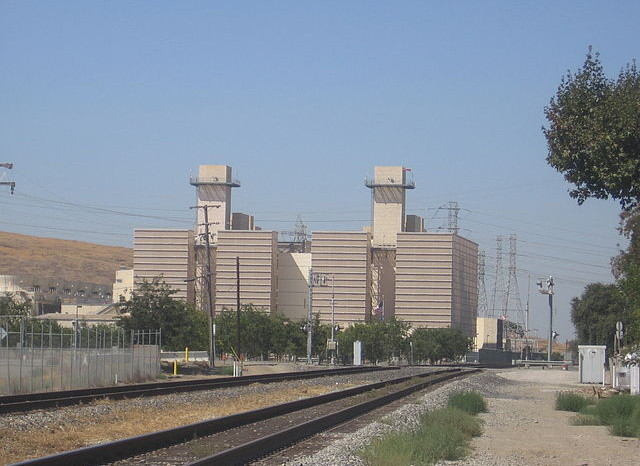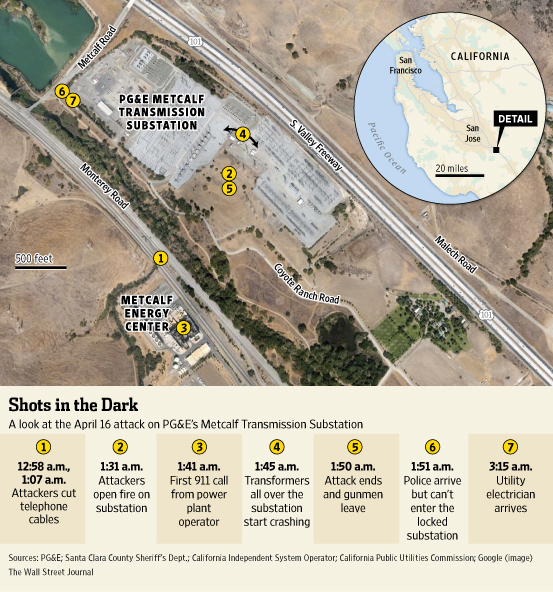Terrorists attack CA Power Station: National Power Grid Vulnerable
Today’s Wall Street Journal (WSJ) had a front page story that raises question of the vulnerability of our national power grid to terrorist attack given an incident that occurred in Silicon Valley in April 2013. It is only now surfacing in the national media, “Assault on Power Grid Raises Alarms”.
In the early morning of April 16, 2013, the Metcalf, California transmission substation in Silicon Valley was attacked by what federal investigators believe was a highly professional terrorist team . That sniper assault caused 17 transformers to crash severing power to Internet Service Providers and other power users in Silicon Valley. Pacific Gas and Electric (PG&E) was forced to increase and reroute power to the area served by the disabled transmission station. The recovery took 27 days for PG&E to repair and bring the transmission substation back online.
Here is the time line of the Metcalf incident as compiled by the WSJ:
At 12:58 a.m., AT&T fiber-optic telecommunications cables were cut—in a way that made them hard to repair—in an underground vault near the substation, not far from U.S. Highway 101 just outside south San Jose. It would have taken more than one person to lift the metal vault cover, said people who visited the site.
Nine minutes later, some customers of Level 3 Communications, an Internet service provider, lost service. Cables in its vault near the Metcalf substation were also cut.
At 1:31 a.m., a surveillance camera pointed along a chain-link fence around the substation recorded a streak of light that investigators from the Santa Clara County Sheriff’s office think was a signal from a waved flashlight. It was followed by the muzzle flash of rifles and sparks from bullets hitting the fence.
The substation’s cameras weren’t aimed outside its perimeter, where the attackers were. The shooters appear to have aimed at the transformers’ oil-filled cooling systems. These began to bleed oil, but didn’t explode, as the transformers probably would have done if hit in other areas.
About six minutes after the shooting started, PG&E confirms, it got an alarm from motion sensors at the substation, possibly from bullets grazing the fence, which is shown on video.
Four minutes later, at 1:41 a.m., the sheriff’s department received a 911 call about gunfire, sent by an engineer at a nearby power plant that still had phone service.
Riddled with bullet holes, the transformers leaked 52,000 gallons of oil, then overheated. The first bank of them crashed at 1:45 a.m., at which time PG&E’s control center about 90 miles north received an equipment-failure alarm.
Five minutes later, another apparent flashlight signal, caught on film, marked the end of the attack. More than 100 shell casings of the sort ejected by AK-47s were later found at the site.
At 1:51 a.m., law-enforcement officers arrived, but found everything quiet. Unable to get past the locked fence and seeing nothing suspicious, they left.
A PG&E worker, awakened by the utility’s control center at 2:03 a.m., arrived at 3:15 a.m. to survey the damage.
Watch this video for the Santa Clara Police Department released in June 2013 published in the San Jose Mercury:
The WSJ noted that PG&E put out a news release saying it was “vandals” who caused the incident. Note what former Federal Electrical Regulatory Commission (FERC) head, Jon Wellinghoff uncovered after the event:
Mr. Wellinghoff, then chairman of FERC, said that after he heard about the scope of the attack, he flew to California, bringing with him experts from the U.S. Navy’s Dahlgren Surface Warfare Center in Virginia, which trains Navy SEALs. After walking the site with PG&E officials and FBI agents, Mr. Wellinghoff said, the military experts told him it looked like a professional job.
In addition to fingerprint-free shell casings, they pointed out small piles of rocks, which they said could have been left by an advance scout to tell the attackers where to get the best shots.
“They said it was a targeting package just like they would put together for an attack,” Mr. Wellinghoff said.
Mr. Wellinghoff, now a law partner at Stoel Rives LLP in San Francisco, said he arranged a series of meetings in the following weeks to let other federal agencies, including the Department of Homeland Security, know what happened and to enlist their help. He held a closed-door meeting with utility executives in San Francisco in June and has distributed lists of things utilities should do to strengthen their defenses.
A spokesman for Homeland Security said it is up to utilities to protect the grid. The department’s role in an emergency is to connect federal agencies and local police and facilitate information sharing, the spokesman said.
The WSJ article drew attention to the problem of replacing the transformers, the target of the Metcalf terrorist attack:
The country’s roughly 2,000 very large transformers are expensive to build, often costing millions of dollars each, and hard to replace. Each is custom made and weighs up to 500,000 pounds, and “I can only build 10 units a month,” said Dennis Blake, general manager of Pennsylvania Transformer in Pittsburgh, one of [only]seven U.S. manufacturers.
Given our work on the EMP threat to our national grid, there are 300 critical transmission substations like Metcalf that are vulnerable to such a terrorist assault. See: Interview with Jerry Gordon on The Electronic Armageddon -The … . A rolling assault by trained terrorist teams against these 300 sub stations could create havoc and a shutdown of the national grid far in excess of the 50 million who lost power when the Northeast grid crashed in 2003. The grid vulnerability is reflected in the limited US manufacturing capacity for large Extra High Voltage (EHV) transformers. Most of the world’s EHV transformer manufacturing capacity is located in China, South Korea and Germany. A study by the National Academy of Sciences indicated that replacement of just the 300 EVH transformers from limited US and offshore producers could take upwards of a decade. Further national security concern is the more than 100 military bases connected to these vulnerable civilian grids. The WSJ article also illustrates the underlying problem of utility industry opposition to HR 2417: Shield Act sponsored by Rep. Trent Franks (R-AZ) which would set standards including provision for standby replacement transformers. Based on work of the Congressionally chartered EMP Task Force a thin shield for the national grid might cost $200 million, while a more robust program could run between $10 to $20 billion. The impact on electric utility users would be an increase in electrical rates per user of less than $.20 cents per annum.
The North American Electric Reliability Corporation (NERC), the principal electric utility standard setting organization, has opposed passage of the Shield Act calling the network “resilient”. Au contraire says an official of Electric Power Research Institute (EPRI) cited by the WSJ: “The breadth and depth of the attack was unprecedented” in the U.S., said Rich Lordan, senior technical executive. “The motivation”, he said, “appears to be preparation for an act of war.” When we checked the websites of House Energy and Commerce Committee Chairman Fred Upton (R-MI ) and Energy and Power Subcommittee Chairman Ed Whitfield (R-KY) their major concerns as regards the security of the grid is vulnerability to cyber attack. According to the WSJ retiring House Energy and Commerce Ranking Member Henry Waxman (D-CA) raised concerns about the lack of federal authority to undertake protective actions regarding the safety of the national grid during FERC oversight hearings in December 2013.
Whether it is a terrorist attack like the Metcalf substation incident, the threat of a massive geo –magnetic storm during or an EMP caused by either North Korea or Iran , this latest WSJ report should embolden US taxpayers and electrical users to request serious Congressional consideration of HR2417: The Shield Act . If any of those events occurred that would bring us back to pre-industrial times. If that occurs, the estimates are that more than 200 million Americans could succumb to a pandemic virus from lack of food, water, sanitation and medical treatment caused by the breakdown of industrial , transportation and communications networks. If you are concerned about this lack of security of the national grid, you should consider signing a petition requesting Congressional consideration of the Shield Act , here.
Listen to this August 2012 Electronic Armageddon Rob Schilling Radio Show interview with Jerry Gordon.
EDITORS NOTE: This column originally appeared on The New English Review.


